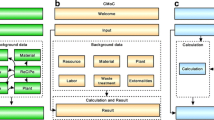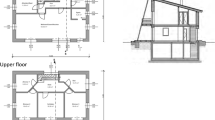Abstract
Life cycle assessment (LCA) is a powerful tool to identify a building’s environmental impact throughout its life cycle. However, LCA does have limits in practice because it does not consider the economic aspect of project implementation. In order to promote LCA application, a more comprehensive evaluation of building life cycle environmental and economic performance must be performed. To address these issues, we propose life cycle green cost assessment (LCGCA), a method that combines LCA with life cycle costing (LCC). In LCGCA the building’s environmental loads are converted to environmental costs based on the trading price of CO2 certified emission reductions (CERs). These environmental costs are then included into the building life cycle cost. Subsequently an evaluation index of green net present value (GNPV) for LCGCA can be obtained. A governmental office building in Beijing was studied using LCGCA. Several design options were compared and the sensitivity of the CER price was analyzed. The research also shows that conclusions reached by LCGCA may be different from those of traditional LCC, which does not include environmental costs. The application of LCGCA needs the support of environmental policies. A sound environmental tax mechanism is expected to be established in China soon, which will enable LCGCA to be a useful tool to guide sustainable building design efficiently.
Similar content being viewed by others
References
Gluch P, Baumann H (2004). The life cycle costing (LCC) approach: A conceptual discussion of its usefulness for environmental decision-making. Building and Environment, 39: 571–580.
Goedkoop M, Spriensma R (2001). The Eco-indicator 99: A damage-oriented method for life cycle impact assessment (Methodology Report), nr.1999/36A. Amersfoort: PRe.Consultants.
Gong ZQ, Zhang ZH (2004). Quantitative assessment of the embodied environmental profile of building materials. Journal of Tsinghua University (Sci & Tech), 44(9): 1209–1213. (in Chinese)
Gu DJ (2006). Building life cycle environmental load evaluation. PhD Dissertation, Department of Building Science, School of Architecture, Tsinghua University, China. (in Chinese)
Gu LJ, Gu DJ, Lin BR, Zhu YX (2007). Study on the effect of different envelopes on life cycle environmental load of residential buildings. Journal of Harbin Institute of Technology, 14(sup.): 431–434.
Huang ZJ (2003). Life cycle assessment model for building energy system and case study. PhD Dissertation, School of Mechanical Engineering, Tongji University, China. (in Chinese)
Jiang JL, Ma XQ (2004). Comparison of the effect of different power sources on the environment based on LCA. Power System Engineering, 20(3): 26–28. (in Chinese)
Li R (2005). Analysis of energy consumption and life cycle assessment of environmental impact of air conditioning cold and heat source. Master Dissertation, Xi’an University of Building Technology, China. (in Chinese)
Li ZJ (2007). Study on the life cycle consumption of energy and resource of air conditioning in urban residential buildings in China. PhD Dissertation, Department of Building Science, School of Architecture, Tsinghua University, China. (in Chinese)
Lin MY, Zhang SS, Chen Y (2004). Life cycle assessment of environmental impact of air conditioning cold and heat source. Heating Ventilating & Air-conditioning, 34 (7): 93–96. (in Chinese)
Long TF, Li MS, Wen GQ, Chen ML (2007). Present status and prospects of clean development mechanism projects in China. Pollution Control Technology, 20(6): 65–68. (in Chinese)
Ministry of Construction P.R.China (2005). GB50189-2005 Energy Saving Design Standard for Public Buildings. Beijing: China Standard Press. (in Chinese)
Reich MC (2005). Economic assessment of municipal waste management systems—case studies using a combination of life cycle assessment (LCA) and life cycle costing (LCC). Journal of Cleaner Production, 13: 253–263.
United Nations Framework Convention on Climate Change (2008). CDM statistics: registration. Available via DIALOG: http://cdm.unfccc.int/Statistics/index.html. Accessed 30 Mar. 2008.
Warren JL, Weitz KA (1994). Development of an integrated life cycle cost assessment model. Paper presented at 1994 IEEE International Symposium on Electronics and the Environment, San Francisco.
Yan D, Xie XN, Song FT, Jiang Y (2004). Building environment design simulation software DeST (1): an overview of developments and information of building simulation and DeST. Heating Ventilating & Air-conditioning, 34(7): 48–56. (in Chinese)
Yan D, Xia J, Tang W, Song F, Zhang X, Jiang Y (2008). DeST—an integrated building simulation toolkit part I: Fundamentals. Building Simulation. (in press)
Zhao JL, Zhuang Z, Li BJ (2005). Study on economical thermal insulation thickness of building envelope. Building Energy & Environment, 24(3): 65–68. (in Chinese)
Author information
Authors and Affiliations
Corresponding author
Rights and permissions
About this article
Cite this article
Gu, L., Lin, B., Zhu, Y. et al. Integrated assessment method for building life cycle environmental and economic performance. Build. Simul. 1, 169–177 (2008). https://doi.org/10.1007/s12273-008-8414-3
Received:
Revised:
Accepted:
Published:
Issue Date:
DOI: https://doi.org/10.1007/s12273-008-8414-3




